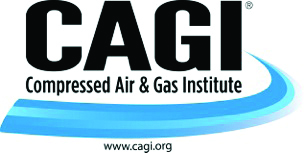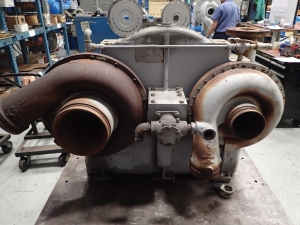 |
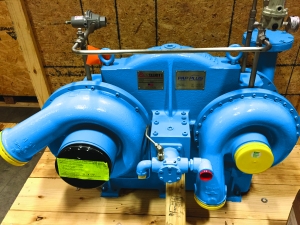 |
A remanufactured centrifugal air compressor.
Centrifugal air compressors are known for reliable longevity, but at some point, end- of- serviceable- life decisions must be made. Your centrifugal compressor has been the lifeblood of the factory for upwards of twenty-five years, or longer, but it is finally showing signs of giving up the ghost. Much like when the aging family automobile continues to rack up increasingly more expensive repair bills, operators of aging centrifugal compressors face the decision to repair or replace the machine when the maintenance costs reach a certain threshold.
As the “old reliable” workhorse reaches the end of its utility, the pending loss has severe consequences to the productivity and profitability of the operation. Fortunately, the centrifugal compressor usually broadcasts its pending demise long before it delivers its last cfm. This allows the operator sufficient time to consider the multiple options he or she has for securing their company’s supply of compressed air.
Replace or Overhaul?
All Centrifugal compressors require regular maintenance and monitoring to keep them operating reliably, efficiently, and safely. In addition to standard maintenance procedures, there are numerous tests and diagnostic procedures that can be performed to reveal the true health of the compressor. Oil analysis, monitoring bearing and impeller vibration, and trending bearing and cooling water temperatures will accurately reveal pending issues with the mechanical operation of the centrifugal compressor. A field test can be performed by a qualified service provider to determine the actual capacity of the compressor and its efficiency compared to as-built performance. Despite all the love and care that a predictive preventative maintenance program can render to extend the useful life of a centrifugal compressor, there comes a time when rising maintenance costs and increased down time force the decision to be made of whether to replace the unit or overhaul the unit. The urgency of action is dictated by the frequency of these unscheduled issues and the productivity costs that these issues create.
Arguments For A New Purchase
There are several reasons why replacing an aging centrifugal with a new unit makes good business sense. A new unit allows for a significant change in the capacity and performance within the system. Although overhauling a centrifugal compressor can include some impeller design changes that increase performance of the old unit, major modifications are precluded. Another new purchase benefit is being able to take advantage of technology updates, especially if the compressor is 10 years old or older. Analog gages, indicator lights, switches, and push buttons have evolved into microprocessor controls with touch screen LCD and PLCs. These updated digital control systems often provide significantly more information and control than their analog predecessors. Such updated systems can provide historical analysis of operational data and can communicate with customer DCS systems allowing for remote monitoring and control of the equipment from a control room.
Technology improvements and design innovations can also mean that new units will have lower operating costs than older existing installed units. This is especially true in the case of electricity. The electricity consumed by an industrial motor over its operating life represents roughly 95% of its total cost of ownership. Large capacity centrifugal compressors often consume hundreds to thousands of kilowatt hours of power consumption PER HOUR of operation. Accordingly, a new more efficient machine that consumes less electricity than the old unit will deliver a breakeven point where the electrical power savings will outweigh the cost of replacing the current unit, especially if the current unit is more than 10 years old.
Other Options To Replacing An Aging Centrifugal Compressor With A New Compressor
Because centrifugal compressors are such mechanically simple and rugged machines, the option to overhaul an aging centrifugal is often very viable and should be considered versus the investment of a new centrifugal compressor. There are two basic overhaul approaches; rebuild or remanufacture.
The rebuild approach to overhauling a centrifugal air compressor typically takes place in situ at the customer site, being performed either by the Original Equipment Manufacturer (OEM) or by a non-OEM service entity. Depending upon the selected service provider, replacement parts can be factory genuine OEM parts or generic, aftermarket components. Product testing after the rebuild is also done in the field, but is often limited to simple mechanical run testing, testing for leaks (air, cooling water, oil), verifying discharge pressure, and measuring vibration.
A key consideration in the decision to overhaul or replace is the time the facility will be without the compressor in question. An extensive repair, complete with coolers, bearings, impeller and shaft inspection and rebalancing, inspections of various components, and possibly even main drive motor maintenance can take several weeks. However, a new compressor often has an extended lead time, often stretching out many months. This makes the overhaul option desirable, especially if the current unit cannot be expected to last through the quoted manufacturing lead time for a new unit.
Remanufactured centrifugal compressors are available in two options. One solution is for the customer to remove the aging or failed compressor and ship it to the OEM factory. There it is overhauled with new or OEM-certified parts and components. Since the OEM has all of the original design drawings and unit specifications for that specific serial numbered compressor, they can restore the compressor back to its original factory specifications and performance. They will also conduct in depth mechanical run and performance tests on the entire compressor package before the unit leaves the factory, assuring that the remanufactured compressor meets or exceeds all customer expectations. Once remanufactured and tested, the remanufactured unit is shipped to the customer and reinstalled for operation.
Another option is to purchase a remanufactured compressor. Several OEMs retain complete, remanufactured compressors in industry-standard capacities and pressures, and these are readily available. If one of these remanufactured units satisfies your capacity and pressure requirements, this option presents a great opportunity to receive a quality remanufactured and factory tested compressor on short notice. Remanufactured inventory is possible due to the large number of standard industry performance machines that have been retired throughout the industry. Normal practice is for the customer to return the failed machine to the OEM for credit once the remanufactured machine has been installed. The “core”, the basic, heavy castings that comprise the bulk of the compressor, is then remanufactured, tested, and put back into OEM inventory.
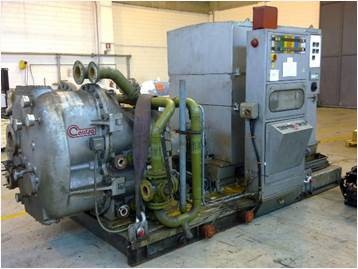
Old compressor.
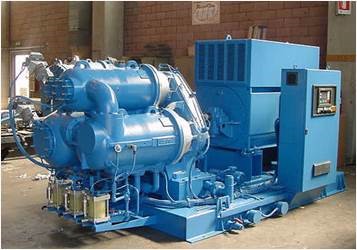
Remanufactured compressor.
System Assessment for Justification
Since both the replace and overhaul options for centrifugal compressors involve significant capital expense, there are many cost considerations that must be reviewed when deciding which option is best for the organization. The actual replacement or overhaul cost, downtime costs, production curtailment penalties, rental costs, removal/reinstallation, and freight costs all must be factored into the final decision. Now that a major expense is imminent, it makes good business sense to gain a thorough and factual understanding of the role that the suspect compressor plays within the entire compressed air system. Although a capability study can provide valuable insight into the actual capacity of the compressor and its performance, significantly more useful information can be obtained by performing a system assessment that looks closely at the supply side, the demand side, and the distribution network of the system. Such an audit will clearly determine the current and future role of the suspect compressor in the overall efficiency of the system. Is it really needed? Is it sized properly? From the system assessment data, the company can formulate accurate decisions with actual payback justification for the chosen solution. The goal of the system assessment is to allow decisions, that affect the efficiency and longevity of the compressed air system, to be made upon facts and data, rather than upon guesses and subjectivity.
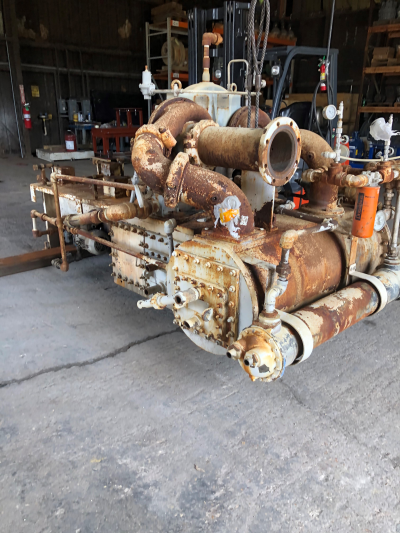
Old compressor.
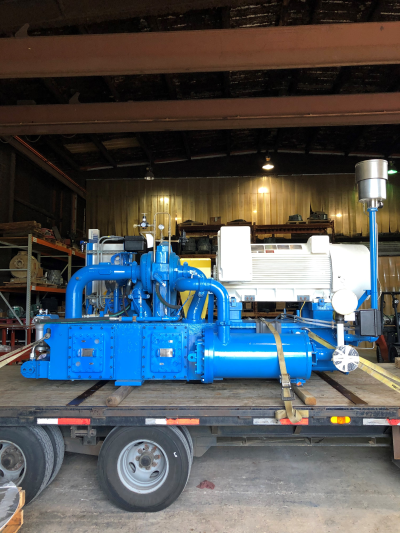
Remanufactured compressor.
Considerations When Choosing An Overhaul Option
The bid for a repair overhaul often starts with a base, initial cost that includes basic parts and services. Customers should be cautioned about making a vendor decision just on the basis of the basic cost since as the disassembly and inspection process gets underway, additional components are often found to be worn or broken. The cost and scope of the repair can, and often does, increase significantly with the addition of each discovered repair item. Unless the initial bid includes a fixed-cost guarantee, these additional parts and labor can quickly inflate the low, base cost well beyond the cost of other overhaul bids or even a new replacement compressor.
Another repair overhaul concern is the form-fit-function of the parts used in the repair process. The quality of both the work and parts used by service providers has a direct impact on the longevity of the repair and the ability of the compressor to perform efficiently. Non-OEM service providers often rely on rebuilt or aftermarket, will-fit parts. Accordingly, the premature failure of an inferior part or the out-of-specification performance of a key component can adversely affect compressor reliability and performance, which adversely affect production and profitability.
Recent tests conducted on compressor coolers supplied by an aftermarket part supplier found many deficiencies in the product design and performance. Most notable was a significant degradation of the cooler performance from OEM specifications. Reduced cooler performance results in both significant capacity and efficiency reductions of the compressor. It’s important to remember that OEMs manufacture, design and test their own coolers to ensure the performance and integrity of this key compressor component. Product quality or adherence to OEM specifications and tolerances cannot be assured when a service provider installs third-party, aftermarket coolers into a rebuild. Below are some questions that should be asked of the service provider when reviewing their bid for a centrifugal compressor repair overhaul:
- Do they use refurbished or aftermarket parts and components?
- Do they use new and OEM certified parts?
- Are they installing completely new bearings, seals, gasket kit, probes, pump, and coupling hub?
- How do they ensure the parts and components are within the manufacturer’s tolerances and specifications?
The remanufactured overhaul bid is normally significantly higher than the initial base-bid for a repair overhaul. However, the remanufactured bid is a known entity. There are no cost overruns or unforeseen issues or delays that are only exposed after the on-site repair is underway. With the remanufactured solution, downtime can be predicted and minimized. The cost of extended, unforeseen downtime due to a repair delay can easily erase the cost difference between the repair bid and the remanufactured bid. Also, with a fixed cost remanufactured solution, there is no need to go back and forth with purchase order revisions or additional purchase order requests, as is frequently the case with the repair option.
Although the remanufactured overhaul option eliminates the downtime that is inherent with a repair, a major consideration when evaluating a remanufactured bid is the work involved in the removal of the current unit and installation of the remanufactured machine. If the machines are exact drop-in replacements of each other, the task is somewhat simplified, but depending on the size, configuration, and location of the machine, this can be a monumental task requiring extensive equipment and time.
Both repair and remanufactured overhaul options are viable solutions, and both have their pros and cons. The decision whether to repair or remanufacture must be made after conducting a comparative analysis between the two solutions based upon the specific logistics and concerns of the facility.
Testing Overhauled Centrifugal Air Compressors Is Critical
Centrifugal compressors utilize precisely machined components that operate at extremely high speeds to deliver compressed air at a specific pressure at a required power consumption. Overhauls, whether repair or remanufacture, are expensive and the expectation is that the overhaul will significantly extend the useful life of the compressor. Accordingly, it is important to measure the efficiency, reliability, and performance of the centrifugal compressor after it has undergone an overhaul to be certain the work was done properly, the unit meets the original quality benchmarks, and the overhaul provides the payback that the customer expected.
No matter whether the decision is to repair or remanufacture, it is important that the finished product be tested before start-up at the customer site. Without such testing, it is impossible to know if the compressor meets new equipment performance standards regarding capacity, discharge pressure, and efficiency. The benefits from testing overhauled centrifugal compressors include:
• Validation of the mechanical integrity of the machine
• Proof that the machine was returned to like-new efficiency
• Minimization of uncertainties and field issues
In depth testing is a particular challenge when a repair is completed at the customer site, as the service provider may not have the necessary testing equipment or expertise to ensure the unit is returned back to the as-designed and as-manufactured specifications, tolerances, and performance. Testing is where a remanufactured overhaul provides a benefit over the in-the-field repair overhaul. At the factory, the compressor can be tested thoroughly to assure that it is mechanically sound, free of oil-air-water leaks, vibration levels are within new equipment specifications, heat exchanger performance is within specification, the remanufactured unit delivers the rated capacity at the specified discharge pressure with “as new” efficiency, and the surge pressure meets new equipment standards.
The following example illustrates the importance of testing. A large U.S. based equipment manufacturer had an air compressor overhauled by a company that did a field repair. The customer was curious to see if the repaired unit met the original capacity and efficiency performance, so they contracted a testing company to test the unit. The testing revealed that the throttling capacity of this trim compressor had decreased by over 80 percent from factory specifications. This resulted in unwanted compressed air bypass and significant energy waste. Based on the test findings, the customer had the OEM overhaul the compressor back to its original performance capabilities, significantly reducing their energy consumption and operating costs.
A Contingency Plan Will Help Avoid Fire Drill Emergencies
Establishing a compressed air contingency plan is paramount to minimizing the risk associated with the unanticipated failure of a critical centrifugal air compressor. The contingency plan should identify all of the critical operations of the facility that would be negatively affected by the loss of a centrifugal compressor. It includes a financial risk analysis that ranks these critical operations according to their probability of occurrence, cost of downtime, and lost production costs. This risk analysis can predict the financial impact of such a failure. The contingency plan should also identify the weaknesses within the compressed air system and provide a plan for performing scheduled maintenance and new equipment installation. With this knowledge, steps can be taken to proactively prepare for the unexpected event to lessen its impact financially and on productivity.
One major aspect of a contingency plan is the pre-arranged contract between a customer and a service provider to provide emergency rental air on quick notice. The contingency plan should establish a schedule for making all of the piping and utility preparations that are required for a quick rental compressor solution prior to the need for rental air. Your compressed air service provider should be able to help you in developing a contingency plan specifically tailored to your facility. The benefits of a compressed air contingency plan are as follows:
- Minimize reaction time when an event occurs
- Minimize production downtime and financial loss
- Reduce delivery time by completing paperwork ahead of time
- Increase employee awareness as to their roles in maximizing productivity
Summary
How to deal with an aging centrifugal compressor, that is exhibiting signs of unreliability, inefficiency, and increased maintenance costs, is a delicate balance between managing risk and minimizing cost. Although purchasing a new compressor is always an option, overhauling or remanufacturing your aging centrifugal air compressor are both viable solutions to improving the reliability, efficiency, and productivity of your compressed air system. When choosing between repairing or remanufacturing a centrifugal compressor, there are many factors to consider and as with all financial decisions, the more information there is, the easier and more accurate the decision. The best way to gather the information needed for a wise, air compressor decision is to perform a system assessment on the existing compressed air system. Armed with the system knowledge and understanding provided by the audit, the user will have the mechanical and financial information necessary to make the best decisions for the facility. Testing the overhauled compressor, whether it be repaired or remanufactured, is a critical step in assuring that the compressor delivers the capacity, efficiency, and reliability as promised by the service provider. As always, a well thought out contingency plan, that anticipates failure events and provides a path for risk minimization, should be created to provide assurance that system integrity is maintained at its highest level while resolving the issue.
|
|
To read more Air Compressor Technology articles, visit https://www.airbestpractices.com/technology/air-compressors.
Visit our Webinar Archives to listen to expert presentations on Air Compressor Technology at
https://www.airbestpractices.com/webinars.
Jan/Feb 2024

